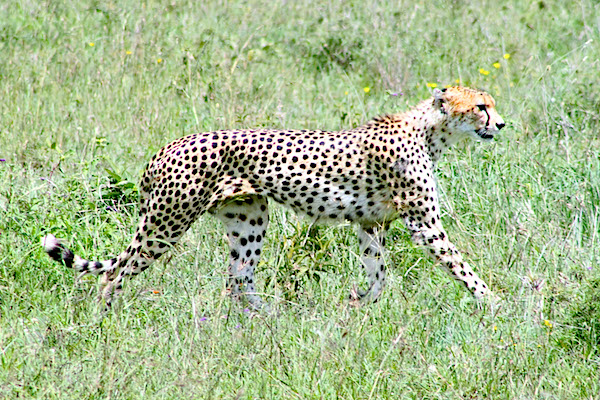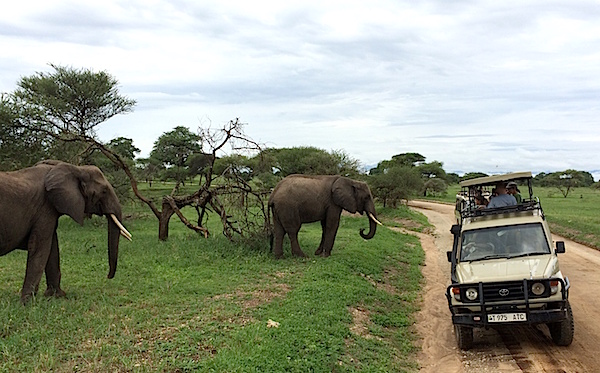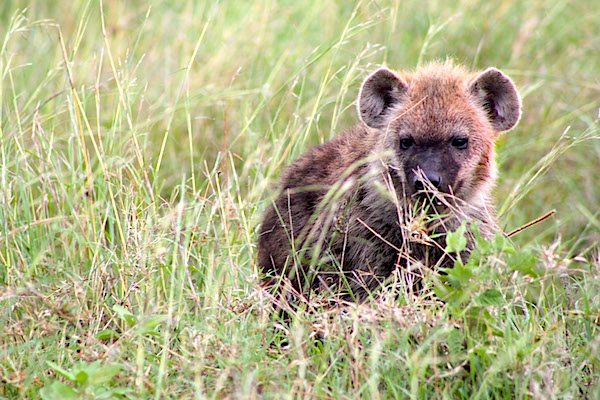 Safaris in national parks in Africa can lead to close encounters with wildlife, such as this cheeta/Sean Smith
Safaris in national parks in Africa can lead to close encounters with wildlife, such as this cheeta/Sean SmithEditor's note: Sean Smith is a former Yellowstone National Park ranger, and an award-winning conservationist, TEDx speaker, and author. He recently had the opportunity to visit some national parks in Tanzania, and returned home with thoughts of what the National Park Service might learn from its African colleagues.
I recently returned to the Northwest after a two-week Tanzanian safari. It was an amazing experience. The trip took us through Arusha, one of Tanzania’s larger cities, out to Tarangire and Serengeti national parks, and the Ngorongoro Conservation Area. The parks and conservation areas were filled with wildlife from the ubiquitous wildebeest to the rare black rhino.
African National Parks share many similarities with their American counterparts.
The parks are big. Serengeti, for example, is more than 3.7 million acres or roughly 1.5 times the size of Yellowstone. Put another way, Serengeti is larger than the state of Connecticut.
The parks are well-visited. Despite having to travel over many poorly maintained dirt roads, parks like the Serengeti and Ngorongoro see roughly 1 million tourists annually.
The parks protect natural and cultural resources. The Tanzanian Park Service, like its U.S. counterpart, protects both natural and cultural resources. Olduvai Gorge in the Ngorongoro Conservation Area protects one of the world’s most important historic sites and some of the oldest fossilized human remains. They like to say at Olduvai, if one traces his/her lineage back far enough, everyone is from Tanzania.
Yet, the Tanzania Park Service diverges from the U.S. National Park Service (NPS) on many issues. The African approach on several issues is an approach the NPS should copy.
Conservation over Recreation
The Tanzania Park Service places conservation and the protection of natural resources and wildlife over private recreation. Nearly every visitor to Tanzania’s national parks has a guide. These guides receive extensive training on resource and wildlife protection. The guides are taught to get the visitors deep into the parks for close-up but safe interactions with the wildlife. Private recreation such as hiking, mountain biking, and swimming is practically non-existent.
Yet, despite this focus on guided rather than private access, park visitors report high satisfaction with their safari adventures.

Elephants seemingly are habituated to humans and their vehicles/Sean Smith
Here in the United States, the NPS mistakenly promotes the idea that it has a dual mandate, one that requires the NPS to balance conservation with recreation. This is incorrect and the courts have consistently ruled that when there is a conflict between conservation and recreation, the law requires the Park Service to favor conservation. The Park Service’s continued pushing of the dual-mandate myth creates undue management headaches, as every recreation interest from snowmobiles to off-lease dog walkers demands access to the national parks. As a result, the national parks are compromised by questionable activities that in many instances do not require a national park setting to enjoy.
Africa takes conservation crimes seriously
Tanzanian park rangers and their African counterparts take environmental crimes seriously. During our safari, I asked our guide if the truck broke down, how would we contact the rangers for help? Our guide responded, “We wouldn’t. The rangers' job was to patrol the borders looking for poachers. We would have to get ourselves up and running again.”
This focus on poaching was recently rewarded when Tanzanian police arrested Feisal Muhammad Ali, the world’s most-wanted ivory trafficker. Meanwhile, rangers in South Africa shot and killed suspected rhino poachers. While I’m not advocating for the summary execution of park criminals, the U.S. government could do more to increase the understanding of the severity of environmental crimes. However, its handling of the Cliven Bundy standoff in Nevada and the courts' unwillingness to impose stiff penalties for poaching sends the message that resource crimes are no big deal.

Hyena in the grass/Sean Smith
Focus on experiences
Another area of focus for the Tanzania park rangers is a on visitor experience rather than amenities. To say the roads of Serengeti and Ngorongoro are rough is an understatement. In some instances, park roads are little more than a mud streak. Meanwhile, the Tanzanian national parks spend little on so-called necessities such as Wi-Fi and cellphone coverage. Interpretive displays are often rudimentary and lack any high-tech whiz bang features found in the United States. However, they provide information in multiple languages, increasing public understanding of why the parks are important.
Rather than providing distractions, the Tanzanian parks focus on preserving authentic experiences. An authentic experience is one that improves a visitor’s appreciation and understanding of park wildlife and natural features, while allowing low-impact intimate interaction with those resources. Unfortunately, many U.S. park activities significantly diminish authentic experiences.
America’s National Park Service will celebrate its 100th birthday in 2016. During the upcoming year, it’s expected the NPS will seek public comment on how best to ensure the park system and Service reach their bicentennial. The agency should look to Africa for guidance.
Sean Smith is a former Yellowstone Ranger, and an award winning conservationist, TEDx speaker, and author. He writes national park thrillers from his home in the shadow of Mount Rainier National Park. To learn more about his conservation work and novels, check out his blog: www.seandavidsmith.blogspot.com or follow him on twitter: @parkthrillers



Comments
One would think, if people are going to travel, that they would either reserve ahead of time, or make sure they have a permit. Most permits are now available online. I wouldn't travel to a NP without some plan in place. It's easy to get burned if you don't, especialy during the summer months.
I don't have a problem per se with permitting - assuming those permits don't go to tour operators in bulk (Pearl Harbor) and they aren't the only means of access. In fact, permitting could be part of a tiered system. Get a permit in advance, one price, pay at the gate, a higher price if crowds warrant it.
[added] The more I think about this the more I like it. The "permitting" website could have a running total of issued permits for each day. People could look in advance and schedule their visit for days with lesser attendance if they want to avoid the crowds.
"To conserve the scenery and the wildlife therein and to provide for enjoyment in such manner and by such means that will leave park resources unimpaired for future generations"...hmmm.
How to do it? The options aren't that many. Here are some thoughts:
(1) Set visitor use limits for peak periods, and have a reservation system with non-transferrable tickets.
(2) Construct high-rise or underground parking garages outside of parks and have shuttle service to key trail heads, limit curio shops and VC's etc., to the vicinty of these mega garages, (I actually prefer PJ Ryan's excellent article in NPT on this very subject, entitled "How Hard Can It Be?" written response to Barbara Moritsch's excellent book "Soul of Yosemite").
(3) While working to discourage the use of private automobiles, invest in train access to parks from major cities, including gateway communities, with discounted travel rates for vets and disadvantaged citizens, Turn the majority of park roads back to dirt, and carefully manage those few remaining paved roads. Keep the paved roads one lane, one way, and curvy.
(4) Set variable prices for vehicle entrances, say $100 per car per day and $200 per tour bus per day for peak season, but otherwise free for non-peak season and free for those who enter the park via foot or bicycle.
(5) Continue to enlarge park infrastructure and in-park parking facilities to meet growing demand considering the fact that eventually the US worker might actually earn as much annual leave as the average European.
(6) Relax and don't do anything different from what's being done at present, recognizing that those who cannot find enjoyment despite the traffic and crowding, may still visit the park once or twice, or come in the so-called off-season, but otherwise they may choose to vacation elsewhere. Those who can adapt to the increased crowding will still enjoy themselves. Unfortunately ecological impacts may inevitably occur, but hopefully these impacts will not be "irreversible."
I'm reminded of earlier days on NPT when two individuals named Beamis and Ranger X once dominated these discussion threads. They often wrote "Save the parks, stay at home!"
Which of these options do you think will be supported by local and regional businesses whose livelihoods depend on park tourism?
Reservation systems for cave tours at Lehman Cave work very well. So does the system for ruins tours at Mesa Verde. Fiery Furnace at Arches is another. Campground reservations using Recreation.gov are easy and efficient if campsites are available.
I have tried three times to make reservations for a campsite in Arches and found I had to be in line about four months early. (Finally managed to make one for five nights in April and now need to cancel because another grand daughter will be arriving about then.)
So in my experience, at least, reservations are a mixed bag. Sometimes easy, sometimes frustrating, sometimes downright maddening. And, under the present set of circumstances, even with reservations one must still contend with all the day users who don't have reservations and need places to park.
ALL solutions require something else, too. That's money. A lot of money in most cases.
It all comes down to one inescapable bottom line THERE AIN'T NO EASY ANSWERS NOWHERE OUT THERE.